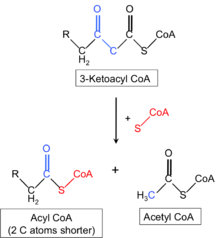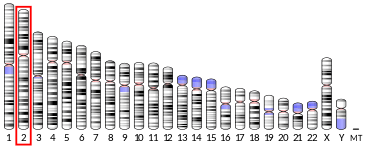HADHB
Trifunctional enzyme subunit beta, mitochondrial (TP-beta) also known as 3-ketoacyl-CoA thiolase, acetyl-CoA acyltransferase, or beta-ketothiolase is an enzyme that in humans is encoded by the HADHB gene.[5]
HADHB is a subunit of the mitochondrial trifunctional protein and has thiolase activity.
Structure
The HADHB gene is located on chromosome 2, with its specific location being 2p23.[5] The gene contains 17 exons. HADHB encodes a 51.2 kDa protein that is composed of 474 amino acids; 124 peptides have been observed through mass spectrometry data.[6][7]
Function

This gene encodes the beta subunit of the mitochondrial trifunctional protein, a catalyst of mitochondrial beta-oxidation of long chain fatty acids. The HADHB protein catalyzes the final step of beta-oxidation, in which 3-ketoacyl CoA is cleaved by the thiol group of another molecule of Coenzyme A. The thiol is inserted between C-2 and C-3, which yields an acetyl CoA molecule and an acyl CoA molecule, which is two carbons shorter.
The encoded protein can also bind RNA and decreases the stability of some mRNAs. The genes of the alpha and beta subunits of the mitochondrial trifunctional protein are located adjacent to each other in the human genome in a head-to-head orientation.[5]
Clinical significance
Mutations in this gene, along with mutations in HADHA, result in trifunctional protein deficiency.[5] Mutations in either gene have similar clinical presentations.[8] Trifunctional protein deficiency is characterized by decreased activity of long-chain 3-hydroxyacyl-CoA dehydrogenase (LCHAD), long-chain enoyl-CoA hydratase, and long-chain thiolase. This deficiency can be classified into 3 main clinical phenotypes: neonatal onset of a severe, lethal condition resulting in sudden infant death syndrome (SIDS),[9] infantile onset of a hepatic Reye-like syndrome, and late-adolescent onset of primarily a skeletal myopathy.[10] Additionally, some presents showed symptoms associated with myopathy, recurrent and episodic rhabdomyolysis, and sensorimotor axonal neuropathy.[11] In some cases, symptoms of the deficiency can present as dilated cardiomyopathy, congestive heart failure, and respiratory failure. The deficiency has presented as hydrops fetalis and HELLP syndrome in fetuses.[12] A compound heterozygous mutation of the HADHB gene can causes axonal Charcot-Marie-tooth disease, which is a neurological disorder, which shows that mutations in this gene can result in deficiencies that present in new forms not currently described.[13]
Interactions
HADHB is a functional molecular target of ERα in the mitochondria, and the interaction may play an important role in the estrogen-mediated lipid metabolism in animals and humans.[14] Additionally, HADHB has been shown to bind to the distal 3’ untranslated region of renin mRNA, thereby regulating renin protein expression.[15]
References
- GRCh38: Ensembl release 89: ENSG00000138029 - Ensembl, May 2017
- GRCm38: Ensembl release 89: ENSMUSG00000059447 - Ensembl, May 2017
- "Human PubMed Reference:". National Center for Biotechnology Information, U.S. National Library of Medicine.
- "Mouse PubMed Reference:". National Center for Biotechnology Information, U.S. National Library of Medicine.
- "Entrez Gene: hydroxyacyl-Coenzyme A dehydrogenase/3-ketoacyl-Coenzyme A thiolase/enoyl-Coenzyme A hydratase (trifunctional protein)".
- ]Zong NC, Li H, Li H, Lam MP, Jimenez RC, Kim CS, Deng N, Kim AK, Choi JH, Zelaya I, Liem D, Meyer D, Odeberg J, Fang C, Lu HJ, Xu T, Weiss J, Duan H, Uhlen M, Yates JR, Apweiler R, Ge J, Hermjakob H, Ping P (October 2013). "Integration of cardiac proteome biology and medicine by a specialized knowledgebase". Circulation Research. 113 (9): 1043–53. doi:10.1161/CIRCRESAHA.113.301151. PMC 4076475. PMID 23965338.
- "Trifunctional enzyme subunit beta, mitochondrial". Cardiac Organellar Protein Atlas Knowledgebase (COPaKB). Archived from the original on 4 March 2016. Retrieved 23 March 2015.
- Spiekerkoetter, U; Khuchua, Z; Yue, Z; Bennett, MJ; Strauss, AW (February 2004). "General mitochondrial trifunctional protein (TFP) deficiency as a result of either alpha- or beta-subunit mutations exhibits similar phenotypes because mutations in either subunit alter TFP complex expression and subunit turnover". Pediatric Research. 55 (2): 190–6. doi:10.1203/01.pdr.0000103931.80055.06. PMID 14630990.
- Sonta, SI; Sandberg, AA (1977). "Chromosomes and causation of human cancer and leukemia: XXVIII. Value of detailed chromosome studies on large numbers of cells in CML". American Journal of Hematology. 3 (2): 121–6. doi:10.1002/ajh.2830030202. PMID 272120.
- Spiekerkoetter, U; Sun, B; Khuchua, Z; Bennett, MJ; Strauss, AW (June 2003). "Molecular and phenotypic heterogeneity in mitochondrial trifunctional protein deficiency due to beta-subunit mutations". Human Mutation. 21 (6): 598–607. doi:10.1002/humu.10211. PMID 12754706.
- den Boer, ME; Dionisi-Vici, C; Chakrapani, A; van Thuijl, AO; Wanders, RJ; Wijburg, FA (June 2003). "Mitochondrial trifunctional protein deficiency: a severe fatty acid oxidation disorder with cardiac and neurologic involvement". The Journal of Pediatrics. 142 (6): 684–9. doi:10.1067/mpd.2003.231. PMID 12838198.
- Jackson, S; Kler, RS; Bartlett, K; Briggs, H; Bindoff, LA; Pourfarzam, M; Gardner-Medwin, D; Turnbull, DM (October 1992). "Combined enzyme defect of mitochondrial fatty acid oxidation". The Journal of Clinical Investigation. 90 (4): 1219–25. doi:10.1172/jci115983. PMC 443162. PMID 1401059.
- Hong, YB; Lee, JH; Park, JM; Choi, YR; Hyun, YS; Yoon, BR; Yoo, JH; Koo, H; Jung, SC; Chung, KW; Choi, BO (5 December 2013). "A compound heterozygous mutation in HADHB gene causes an axonal Charcot-Marie-tooth disease". BMC Medical Genetics. 14: 125. doi:10.1186/1471-2350-14-125. PMC 4029087. PMID 24314034.
- Zhou, Z; Zhou, J; Du, Y (July 2012). "Estrogen receptor alpha interacts with mitochondrial protein HADHB and affects beta-oxidation activity". Molecular & Cellular Proteomics. 11 (7): M111.011056. doi:10.1074/mcp.m111.011056. PMC 3394935. PMID 22375075.
- Adams, DJ; Beveridge, DJ; van der Weyden, L; Mangs, H; Leedman, PJ; Morris, BJ (7 November 2003). "HADHB, HuR, and CP1 bind to the distal 3'-untranslated region of human renin mRNA and differentially modulate renin expression". The Journal of Biological Chemistry. 278 (45): 44894–903. doi:10.1074/jbc.m307782200. PMID 12933794.
Further reading
- Wang R, Yang Z, Zhu JM, et al. (2006). "[Screening for G1528C mutation in mitochondrial trifunctional protein gene in pregnant women with severe preeclampsia and new born infant]". Zhonghua Fu Chan Ke Za Zhi. 41 (10): 672–5. PMID 17199921.
- Aboulaich N; Vainonen JP; Strålfors P; Vener AV (2004). "Vectorial proteomics reveal targeting, phosphorylation and specific fragmentation of polymerase I and transcript release factor (PTRF) at the surface of caveolae in human adipocytes". Biochem. J. 383 (Pt 2): 237–48. doi:10.1042/BJ20040647. PMC 1134064. PMID 15242332.
- Adams DJ, Beveridge DJ, van der Weyden L, et al. (2003). "HADHB, HuR, and CP1 bind to the distal 3'-untranslated region of human renin mRNA and differentially modulate renin expression". J. Biol. Chem. 278 (45): 44894–903. doi:10.1074/jbc.M307782200. PMID 12933794.
- Spiekerkoetter U, Khuchua Z, Yue Z, et al. (2004). "General mitochondrial trifunctional protein (TFP) deficiency as a result of either alpha- or beta-subunit mutations exhibits similar phenotypes because mutations in either subunit alter TFP complex expression and subunit turnover". Pediatr. Res. 55 (2): 190–6. doi:10.1203/01.PDR.0000103931.80055.06. PMID 14630990.
- Kimura K, Wakamatsu A, Suzuki Y, et al. (2006). "Diversification of transcriptional modulation: large-scale identification and characterization of putative alternative promoters of human genes". Genome Res. 16 (1): 55–65. doi:10.1101/gr.4039406. PMC 1356129. PMID 16344560.
- Bogenhagen DF, Rousseau D, Burke S (2008). "The layered structure of human mitochondrial DNA nucleoids". J. Biol. Chem. 283 (6): 3665–75. doi:10.1074/jbc.M708444200. PMID 18063578.
- Middleton B (1994). "The mitochondrial long-chain trifunctional enzyme: 2-enoyl-CoA hydratase, 3-hydroxyacyl-CoA dehydrogenase and 3-oxoacyl-CoA thiolase". Biochem. Soc. Trans. 22 (2): 427–31. doi:10.1042/bst0220427. PMID 7958339.
- Zhao Y, Meng XM, Wei YJ, et al. (2003). "Cloning and characterization of a novel cardiac-specific kinase that interacts specifically with cardiac troponin I.". J. Mol. Med. 81 (5): 297–304. doi:10.1007/s00109-003-0427-x. PMID 12721663.
- Behrends C, Sowa ME, Gygi SP, Harper JW (2010). "Network organization of the human autophagy system". Nature. 466 (7302): 68–76. doi:10.1038/nature09204. PMC 2901998. PMID 20562859.
- Purevsuren J, Fukao T, Hasegawa Y, et al. (2009). "Clinical and molecular aspects of Japanese patients with mitochondrial trifunctional protein deficiency". Mol. Genet. Metab. 98 (4): 372–7. doi:10.1016/j.ymgme.2009.07.011. PMID 19699128.
- Hillier LW, Graves TA, Fulton RS, et al. (2005). "Generation and annotation of the DNA sequences of human chromosomes 2 and 4". Nature. 434 (7034): 724–31. doi:10.1038/nature03466. PMID 15815621.
- Spiekerkoetter U, Sun B, Khuchua Z, et al. (2003). "Molecular and phenotypic heterogeneity in mitochondrial trifunctional protein deficiency due to beta-subunit mutations". Hum. Mutat. 21 (6): 598–607. doi:10.1002/humu.10211. PMID 12754706.
- Gerhard DS, Wagner L, Feingold EA, et al. (2004). "The status, quality, and expansion of the NIH full-length cDNA project: the Mammalian Gene Collection (MGC)". Genome Res. 14 (10B): 2121–7. doi:10.1101/gr.2596504. PMC 528928. PMID 15489334.
- Ota T, Suzuki Y, Nishikawa T, et al. (2004). "Complete sequencing and characterization of 21,243 full-length human cDNAs". Nat. Genet. 36 (1): 40–5. doi:10.1038/ng1285. PMID 14702039.
- Fould B, Garlatti V, Neumann E, et al. (2010). "Structural and functional characterization of the recombinant human mitochondrial trifunctional protein". Biochemistry. 49 (39): 8608–17. doi:10.1021/bi100742w. PMID 20825197.
- Strausberg RL, Feingold EA, Grouse LH, et al. (2002). "Generation and initial analysis of more than 15,000 full-length human and mouse cDNA sequences". Proc. Natl. Acad. Sci. U.S.A. 99 (26): 16899–903. doi:10.1073/pnas.242603899. PMC 139241. PMID 12477932.
- Ibdah JA, Tein I, Dionisi-Vici C, et al. (1998). "Mild trifunctional protein deficiency is associated with progressive neuropathy and myopathy and suggests a novel genotype-phenotype correlation". J. Clin. Invest. 102 (6): 1193–9. doi:10.1172/JCI2091. PMC 509102. PMID 9739053.
- Gevaert K, Goethals M, Martens L, et al. (2003). "Exploring proteomes and analyzing protein processing by mass spectrometric identification of sorted N-terminal peptides". Nat. Biotechnol. 21 (5): 566–9. doi:10.1038/nbt810. PMID 12665801.
- Hendrickson SL, Lautenberger JA, Chinn LW, et al. (2010). "Genetic variants in nuclear-encoded mitochondrial genes influence AIDS progression". PLoS ONE. 5 (9): e12862. doi:10.1371/journal.pone.0012862. PMC 2943476. PMID 20877624.
- Frackowiak J, Mazur-Kolecka B, Kaczmarski W, Dickson D (2001). "Deposition of Alzheimer's vascular amyloid-beta is associated with decreased expression of brain L-3-hydroxyacyl-coenzyme A dehydrogenase (ERAB)". Brain Res. 907 (1–2): 44–53. doi:10.1016/S0006-8993(01)02497-0. PMID 11430884.
External links

- HADHB+protein,+human at the US National Library of Medicine Medical Subject Headings (MeSH)
This article incorporates text from the United States National Library of Medicine, which is in the public domain.



